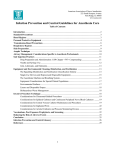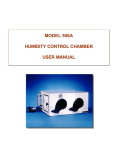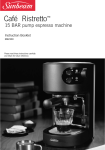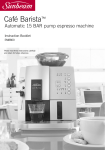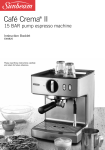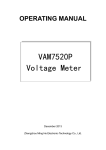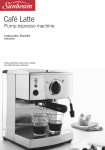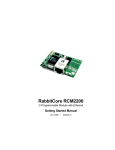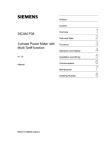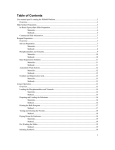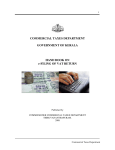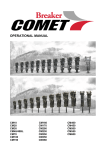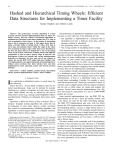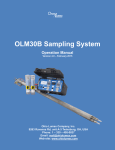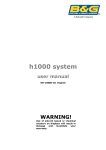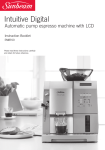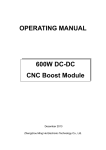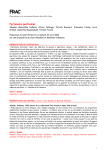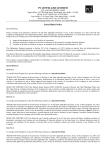Download Tube Fan -Team Zephira
Transcript
ZEPHYRIA Sarah Griffis, Edward Guozhi Huang, Johny Varghese, Vigil Vijayan, Joju Zacharias 1 [Executive Summary] The Zephyria Company aims to alleviate the problem of sleeplessness in India due to extreme heat. This problem was refined from the general problem of heat. The problem affects many around the world, but by targeting a small section of India’s population first, the Zephyria Company will be able to better refine the fan tube product; our product is also called the Zephyria. This target market is agricultural or other outdoors workers in the Indian state of Kerala. By conforming to the constraints of cost and effectiveness while keeping a very easy to manufacture product, the Zephyria will be an effective solution to the problem defined and a profitable business venture. As we have developed our product and business ideals, we have focused on cost, manufacturability, and effectiveness. Through these three elements we reengineered the fan tube idea from the SleepBreeze. We also considered the human design component and culture of tradition. Through our business plan, we were able to come up with target numbers to sell and a strategic marketing plan for Kerala. Overall the Zephyria Company will be a combination of engineering and design principles working together with marketing and business factors in Kerala. The versatility of the Zephyria product will eventually allow branching to other states in India and other developing countries. 2 [Problem Statement] The Indian state of Kerala has experienced extreme heat waves in the past years, with temperatures reaching up to 44 °C [1]. Methods of cooling in India currently include fans and air conditioners; however, the less than reliable source of electricity in India hinders the effectiveness of these devices. Moreover, the cost of an air conditioner and the associated electric bill is too expensive for most people living in India to afford. Agricultural workers and others exposed to high temperatures can suffer from heat exhaustion and heat stroke. Additionally, it is well documented that heat exposure can cause trouble sleeping [2]. Adding to the complications of a good night’s rest, prolonged UV light exposure can cause uncomfortable sun burns, which produce a warming sensation due to increase circulation from the healing process [3]. [Mission Statement] Based on the problem stated above, Zephyria is a for profit company interested in distributing a cost effective device (the Zephyria) that will allow India people to sleep comfortably by means of cooling their personal space. We believe a quality night’s sleep is essential for both productivity in the work place and maintaining a quality of living. Adhering to high business standards, we insist the Zephyria to be both effective and durable. Yet we are also aware of the necessity of low cost in order to reach a wider majority of the Indian “blue collar” population. In order to meet this cost constraint, we are making the manufacture and the repair of the Zephyria local to our customers in Kerala. However, we are not sacrificing the safety of our users or workers when cutting costs. Over all, the Zephyria benefits communities in Kerala by increasing worker productivity, aiding in economic stability by the addition of job opportunities, and improving the standard of living. [Market Definition] Based on the primary research of our target market, we indentified Kerala people whose primary source of employment required outdoor labor as our main customers. Specifically, we found that three factors determined our primary market: 1. The Indian people most affected by the heat are those who work outdoors. 2. Those who work outside are between the ages of 20-60. 3. We have more access to reliable information about people and resources in Kerala, near Saint Gits University. 3 To summarize, we will have a primary market which will be targeted when we begin production (less than 5 years of business). Our secondary market will be those customers that we will reach out to after stabilizing Zephyria financially. Primary Market: 1. Agricultural or other outdoor workers, living in Kerala between 20-60 years old. Secondary Markets: 1. Lower income people in Kerala. 2. Outdoor laborers in India. 3. Lower to middle income people in India. As a guide for how robust our market is, we acquired data on the demographics of our primary target market. According to the CIA, 64.3% of the population of India is between 15 to 64 years of age; Kerala follows the same pattern [4]. The growth rate of Kerala as of 2003 was 9.42%, one of the lowest in all of India [5]. Seventy-four percent of Keralans live in rural areas [6] and agriculture contributes 12.77% of the GDP of Kerala [6]. Based on these figures, are target market is a very stable section of the population in Kerala, and therefore will be a strong section to pursue. (Total Kerala Population = 31.8 million) Younger than 15 or Older than 64 Agricultural Non-agricultural Between 15 and 64 Years Old Figure 1 and 2. Distribution of Population of Kerala 4 In addition, we realize the importance of tradition in India. It is evident from our market research that fans are extremely popular forms of cooling devices in India. The Zephyria is a very innovative device, whose form is very anti-traditional compared to fans currently on the market. We realize that although our target market (agricultural and outdoor workers in Kerala) is interested in a more effective cooling device, they may also be skeptical of a completely revamped design of a fan. Therefore, we expect that our initial customers will be appreciators of innovation. They will be those people who are leaders of new technology in their communities. [Product Constraints - Cost, Effectiveness & Manufacturability] From primary research conducted in Kerala, we obtained information pertaining to what was necessary in a cooling device in India. The results of these surveys can be found in Appendix 1. From these surveys, we formulated several key constraints pertaining to the design of the Zephyria: 1. Customers are able to pay a limited amount for a cooling device. This amount is around what customers are now paying for fans, their current method of cooling. 2. Rural Indian people are not comfortable trying to sleep at night. Indian people would prefer a more effective method and could be willing to purchase a new cooling device. 3. Traditional air conditioners are not an effective solution due to cost of the air conditioner and cost of energy usage. From these hypotheses, we realized cost and effectiveness were extremely important from a consumer perspective. From the Zephyria perspective, we are also very concerned with manufacturability. Taking these issues into account, we considered a variety of cooling devices. After the analysis based on primarily on cost, manufacturability, and effectiveness, the general concept of a fan tube emerged (see picture below). Complete analysis can be seen in Appendix 2. The fan tube is a device with a fan connected to a tube with holes in it (see Figure 3). A person lies down next to the holes and is cooled by the air flow from the holes. The gently relaxing zephyr produced by our product is where we the name “Zephyria” originates. Relying primarily on a fan, a cooling device many can afford in India, the personal fan tube is cost efficient. The personal fan tube is extremely effective, as it directs wind evenly over the 5 human body. Due to its limited mechanical and electrical parts, the fan tube is very durable and energy efficient. Figure 3. Fan Tube [7] Additionally, the fan tube addresses problems specific to India. The fan tube can utilize local Indian materials; for example, we can take advantage of local cloth to make the tube part of the product. In addition, considering India’s unreliable power supply system, the fan tube can easily include a rechargeable battery. The battery will recharge during normal use and will provide electricity during times of limited electricity. [Product Design] We chose modular architecture in order to isolate and simplify our design into components. The fan, tube, and the end component need to be easily assembled and easily detachable for proper use and maintenance. Thus, the type of modularity employed in our device is sectional, as each component is connected to each other linearly instead of to a central hub. A schematic of the device can be seen below. 6 Electricity POWER Conduct electricity Store electricity SUBSYSTEM Generate rotation MOTOR SUBSYSTEM Generate air flow Conduct air flow Stabilizer WIND SUBSYSTEM STABILIZATION SUBSYSTEM Distribute air flow Human body Figure 4. Zephyrua Schematic Diagram The fan is powered by electricity and batteries. The fan is connected to the tube system by glue and bolts. This allows the air generated by the fan to be directed through the tube. The air proof tube with holes allows air to pass through the tube and out through the holes, creating a breeze through each hole. The weight at the end of the tube stabilizes the tube. Figure 5 shows the complete structures. 7 Power Subsystem Fan Subsystem Plug Case Fan Battery Motor Adapter Assembled Zephyria Zipper goes around this adapter and one end of the tube Figure 5. Zephyria Clusters [Cost] Our personal fan tube, the Zephyria, is a fairly simple idea; therefore, we have a simple and elegant design. For example, on the fan we are only going to have one on/off switch that is very intuitive for the user (no overdesign the personal fan tube). The switching between external electricity supply and battery is done automatically (similar to an alarm clock that runs on battery or external power) so the user does not need to do anything. This 8 simple design means our product is also easy to assemble. An easy assembly aids in keeping manufacturing costs low. Also, the dimensions of parts of the Zephyria have some flexibility; therefore, the cost of manufacturing the device is low. For example, the length of the tube can be variable without changing the effectiveness of the device. Additionally, we do not have many parts to assemble, reducing the cost of manufacturing. Our costs of labor should be low, as we only need people to work on an assembly line. 12 cm 12cm Diameter = 4±1cm Fan (Side View) ↑ Side View Holes ube Length = 1.5 ± 0.1m Tube Diameter = 10±1cm Fan Cool breeze Zippers Tube ↑ Top View Figure 6. Zephyria’s Dimensions We will purchase parts from local Indian supplier at a very low cost. For the wind tube part, we will use Kerala’s local cloth that’s available in India due to its low cost and high availability. We will also manufacture our product in India to further reduce the transportation and labor cost. Our parts can be of common sizes, since our device is only slight constrained by size (needs to be approximately 5 feet long). Compared to the SleepBreeze [7] already on the market, we will make our device cheaper. We will not include the extra features of the SleepBreeze such as an electrical system to allow the user to set times for the SleepBreeze to go on and off. By eliminating this 9 technology, we will drastically reduce the price. Also, we will be assembling the device and buying parts in India, not the UK, which should lower the cost. In order to determine a rough estimate of the Zephyria, we made a few assumptions: 1. whole sale price is 50% of retail price found online; 2. The tube part of Zephyria is 0.1 meter in diameter, 1.5 meters in length (equals to about 0.5 m2 of material); 3. 20% of nylon cloth becomes scrap material during the manufacturing process; 4. the battery used is similar to a camcorder battery; 5. It takes about 30 minutes to assemble one unit of Zephyria; Component Fan* Tube (nylon cloths)* Zippers Battery (optional) Purchased Processing Labor Assembly Total Unit Material (machining) Labor Variable Cost $11.07 $11.92 $1.07 $1.07 $0.57 $0.57 $5.50 $0** $0.85 $5.50 Plugs and wires $2.50 $2.50 Manual $0.10 $0.10 Packaging $0.20 $0.20 Total Cost: $21.86/$16.36 Table 1. Unit Variable Cost of Zephyria *We have contact wholesale sellers about fans and nylon to try and obtain whole sale prices; however, we have not heard back. We believe these wholesale prices will be less than the prices we found online for materials. **We are not making any of our parts, we are only assembling parts. References to the costs listed above are shown in Appendix 3. [Maintainability and Reliability] We will distribute our products through some intermediate agencies that have distribution channels in different parts of India (at least in Kerala). The simplicity of our product makes it highly maintainable and reliable. Everyone who works at an electrical shop in India who knows how to repair a fan can repair our fan tube system. We will also be 10 supplying the tube itself as a replacement part in the shop such that the users can replace the tube themselves if the original tube on their fan-tube system is damaged. Similarly, we will also offer replacement battery for the system should the original battery becomes unable to hold charge (although battery is completely optional because our system can operate normally without a functioning battery). As for reliability, since our product is mainly based on fans which have been proven in India to be highly reliable (~20 years of lifetime on average), and the rest of our product does not have any mechanical components, the overall reliability will be satisfying as long as we keep our design simple. [Human Design] Our product is very easy for consumers to use. There is only an on/off switch, with no other buttons; therefore, it s use is completely intuitive. Additionally, we will have a picture of a person using the fan tube, similar to the Figure 3. This picture will illustrate how to use the product. This picture also prevents misuse of the fan tube, as it shows the customer how it is supposed to be properly operated. However, we do have the problem of accidently misuse during the night. There is a possibility that users with kick over or roll onto the personal fan tube when sleeping. To try and avoid this, we will suggest an optimum distance away from a person the fan should be placed (this distance is yet to be determined). Additionally, we are concerned with electrical fires started during the night by accidental movement of the fan tube (e.g. rolling on the fan tube). In order to maintain a safe device, we will put a thermocouple in the electrical-fan interface so that if the temperature becomes too hot the device will shut off. The user manual for our device will be very simple. It will include how to use the product (using the picture above). It will include how far away the fan tube should be places from the body (distance to be determined). The manual will also include a “troubleshooting” section. This section will include a description of the spare parts a user can buy if theirs breaks. For example, if the tube tears, they user can buy a replacement. Also, this section will explain that the fan or electrical system may have to be repaired at a shop if the device is not working. We will explain how the fan turns off automatically if it gets too hot, so the user should wait some minutes until the device cools down for the personal fan tube to work again. 11 Although we were initially concerned with the sound affecting consumers, the fan used will be no louder than the fans already used in India. Therefore, we do not foresee loudness being a problem or complaint for the Zephyria. [Manufacturability] It is very cheap to buy the items needed to make our device. Additionally, there are only a few items (relative to other projects) that we need to make our project. Therefore, we will buy a fan, tube (nylon cloth), zippers, batteries, plugs and wires and assemble them. As for our inventory strategy, we will only make a few to start with. We will not rent a factory until we have the need to do so. Then when the product gains momentum from advertising and word of mouth, we will increase production. As we hire more workers, it will be necessary to keep them satisfied. Part of this includes our ethical plan, outlined in the Ethical Plan section below. Training workers will be simple because it will be assembly line work. Little training will be needed. As for governmental and regulatory issues, we are planning on using materials from India, so we will not encounter any import problems. Also, our product should not encounter any regulatory issues since it does not contain any environmental hazards (besides the possibility of a battery) or other concerns. [Prototyping] In order to determine preliminary issues we will run into when manufacturing, we built prototypes in both the USA and India during this term. In India, we made every part of the prototype from scrap material. The blades for the fan are made of gauge 26 aluminum sheets. First, the shape of the blade is drawn in the sheet. Then, it is cut out using the sheet cutting scissors. It is folded in the required angle and shape using pliers and hammed. A plastic cap is used to make the hub of the fan blade. The blades are screwed tightly to the body of the hub using ½ inch long steel screw. To fix the hub tightly to the motor shaft, a plastic pulley is fixed to the hub. The pulley fits tight to the shaft and is then screwed to a round aluminum sheet, which is fixed to the bottom of the hub. A PVC pipe of diameter 5 inch and length 8 cm forms the basic body structure. A 1 inch wooden reaper is used to make the support for the motor. Three 5 cm long pieces of reapers are screwed to a circular frame of the size of the motor. The motor sits firmly inside the frame and the other end of the three reapers are then screwed to the inner wall of the PVC pipe. The 2 inch wooden reapers are used to make a rectangular shaped body for the fan. The PVC pipe is fixed inside the rectangular box giving it the same size and shape of the 12 actual design. Plastic mesh is fitted on the inlet and outlet side of the fan. Then, Velcro is glued to the circumference of the PVC for fitting the cloth tube. In order to make the tube, a piece of smooth cloth is sewed to make a tube of 1.5 m long and 10 cm in diameter. Holes of diameter 4cm are made on the tube at 15 cm apart. Finally, a 12V and 300mA transformer and a bridge rectifier is used for making the DC adapter. In the end, an on/off switch is fitted to the body of the fan. From this process, we have learned that although making a fan from scrap metal is possible and extremely cheap, the fans already on the market are cheap and more convenient to use for our product. 1st Prototype - Making Blades form Scrape Steel 1st Prototype - Blades 2nd Prototype - Fan 2nd Prototype - Case Figure 6. Indian prototype In America we ordered the SleepBreeze from the U.K, a personal fan tube system already in the market. We will use the structure of the SleepBreeze to design our working prototype in the U.S. We took out some features that we think will not be very useful to 13 Indian customers (such as timer) and improved the interface between the fan subsystem and tube subsystem such that customers can easily replace the tube part. For example, the Velcro used to attach the fan and the tube in SleepBreeze was very difficult to assemble together. We will either try to improve the Velcro interface, or simply use a zipper mechanism instead. Additionally, we verified that it is not necessary to have wire or plastic framing in the tube part of the Zephyria by removing the plastic wire from the SleepBreeze. However, we learned that the fan use in the SleepBreeze is not as powerful as we would like. We will therefore use stronger than a 12 volt fan in the Zephyria. [Business Plan] The financial security of our company will increase over time. At the beginning, we will have high costs and sell fewer units than in future years. In order to avoid extinction, we will raise a large amount of money from NGOs and reduce monthly expenditure (salaries, equipment, etc.) to the minimum. We will decrease the time of our product to reach the market. Over time, the number of units sold will increase as costs of manufacturing decrease and we will become more stable. To quantity our plan, a five year financial plan of Zephyria is included in Table 2. Gross Revenue Number of units sold Price Total Funds Gross Revenue + Money Raised Year 1 Year 2 Year 3 Year 4 Year 5 1000 40 1500 35 4000 30 8000 27 15000 27 45000 52500 120000 216000 405000 Direct Cost: $21.86/unit 21860 32340 86240 172480 323400 Gross Profit Total Funds – Direct Cost 23140 20160 33760 43520 81600 Allocated Expenses Advertising and Marketing Physical Plant Transportation (Shipping) Quality Assurance Insurance and Legal Taxes Storage R&D Salaries Utility Total Allocated Expenses 354 0 120 520 0 5625 0 100 6000 1320 14039 354 3293 120 520 0 6562 0 100 6000 1320 18269 354 3293 120 520 0 15000 0 100 6000 1320 26706 354 3293 120 520 0 27000 0 100 6000 1320 38706 354 3293 120 520 0 50625 0 100 6000 1320 62331 Net Profit Gross Profit – All Allocated Expenses 4101 1891 7053 4813 19268 Table 2. Five-year Financial Plan All numbers are in US Dollars. Explanation and rationalization of revenue is given below, and background for allocated expenses can be found in Appendix 4. 14 Initial Funding We plan to raise funds from various NGOs. We believe these investors will be intrigued by both the engineering simplicity and the social benefit provided by our product. NGOs will be interested in the standard of living increase the Zephyria can provide, as well as the employment opportunities in local communities we will have to offer. We also will seek private investors who are interested in social entrepreneurship. Because the Zephyria is very cheap and easy to assemble, donations we will be asking for will be very reasonable to investors. Sales Forecast The forecast of the number of Zephyrias sold every year is dependent on our target market, agricultural workers, or other outdoor laborers, living in Kerala between 20-60 years old. Of the 31.8 million in Kerala, 74% live in rural areas and half of Keralans are dependent on agriculture for income. We expect that our target market when product is first introduced will be those with an appreciation for innovation, since the fan tube is unlike traditional fans. After time, we expect our product to gain popularity by word of mouth and familiarity with our product. Also, we will give our fan tube to community leaders, or those who have a strong following to aid in spreading the word about our product. Additionally, we expect to be able to reduce the price of our product (see Price Analysis below). Therefore, we expect a low number of fan tubes to be sold at first, with the next years gaining considerable momentum in sales. Price Analysis Our initial price to customers will be higher than in subsequent years. As our manufacturing costs go down and we have more financial stability, we will be able to decrease the price of the fan tube to customers. We want to have a net positive profit the first year, so we will have a price of $40.00, which is about twice the unit variable cost. Then we will gradually reduce the price. In our five year plan, we assumed the unit variable cost remained constant over time; however, we think this cost will decrease. Therefore the price we charge will go down even further than we have outlined in our five year plan (consider the price to customers as maximums charged). Summary Based on the figures above, we will have cumulative profits that increase as follows: 15 Cumulative Profit $40,000 $35,000 $30,000 $25,000 $20,000 $15,000 $10,000 $5,000 $0 Year 1 Year 2 Year 3 Year 4 Year 5 Figure 7. Cumulative Profit Our profits will steadily increase. After five years, we will be in the financial position to branch out from our primary market in Kerala to other parts of India. We believe that it will be possible to market the Zephyria in India’s major cities by more traditional forms of advertising, like billboards and TV advertisements. Additionally, our product will be a position to branch out internationally to other countries. We believe partnerships with NGOs in Africa are one potential avenue for the Zephyria. [Ethical Plan] The Zephyria Company will adhere to high business ethics, both for our company and for our product. As a company, we will not give in to bribes while starting our company. Instead, we will show local officials how beneficial our product is, and how we are strengthening the community with jobs. We believe this argument will deter those who may have wanted to hinder our entry to the market. Additionally, we will treat our workers with respect. This includes giving our workers a living wage and keeping working conditions safe. We believe our workers will have more than just labor value. We know that our workers may have valuable insight into how to improve our product or production facilities; therefore, we want to offer an environment of cooperation. 16 As a product, we will keep the local environments clean. We will not use harmful materials or have harmful byproducts. Our product will not do harm to people while in use. Specifically, we will not use sharp blades that may injure people while the fan is in motion. We will pay careful attention to wiring so that electrical fires will not happen at night. We will guarantee our product will work for a reasonable amount of time, and will be replaced if a broken Zephyria is purchased. We will take all claims of unethical behavior my employees seriously. All claims, no matter the severity, will be investigated. We believe this will encourage responsible behavior. All employees will be made aware of our policies. [Future Directions] The prototype built in India will be used to obtain consumer suggestions about the Zephyria before production. We will incorporate these suggestions in to our final design. Additionally, we will continue to improve our design in the U.S. One major improvement we are considering is the addition of a drying material between the fan and the tube (Figure 8). This layer would be “charged” and dried out during the day by being left in the sun to dry. Then at night the layer would be inserted back into the Zephyria for use. Layer of drying material Figure 8. Future Improvements for Zephyria Materials like drierite, calcium sulfate, are well known to be excellent drying materials. Drierite can be used to absorb moisture from the atmosphere. By adding a layer of drierite between the fan and the tube, we will decrease the humidity of the air that runs through the tube and out through the holes. This drier air will feel cooler as it passes over the user’s body. In a very humid environment like in Kerala, a fan that blows dry air will be a 17 dramatic improvement to traditional fans. The combination of targeted air flow and dry air will be a significant improvement. However, we are concerned with the environment effects of drierite. Additionally, we are concerned with human exposure to the substance and potential for small children to ingest the drierite. Further research is needed to determine if drierite is a potential improvement to the Zephyria. In the coming months, we will need to get better information about running a business in India. For example, we need to get variable costs about the components of the Zephyria from places in Kerala. We need to obtain more information on costs based on prices in India, instead of estimates from other places around the world. Additionally, we should build a few prototypes and distribute them to people in India. These will be our first products and may have issues that need to be resolved before putting the Zephyria on the market. [Challenges] Initially only had a vaguely defined existing problem for us to find solution for. We had not decided if we were trying to cool people who were working outside, indoor places, or just people themselves. After careful discussion and evaluation, we finally reached a consensus that we would target on cooling people themselves. We had problems with communication initially, due to different time zones (~12 hour difference), accent, and culture. Additionally, online video talk through Google chat and Skype was not reliable. We found that sometimes it was easier to chat by typing, and when it is necessary to talk, we would try to pay to call via cell phones. Also due to the distance, it is very hard for us to communicate regarding our prototypes. Since we are making prototypes in both America and India, it will be very beneficial if we could see each other’s product. But due to limitations in communication, we were not able to do that in an effective way. We also had information challenge. We obtained valuable data from the internet; Sarah and Edward determined our financial plan based on USA numbers, which we suspect may be very different from numbers in India. We had to consult our teammates in India to find out more accurate data (such as utility, transportation and rent). 18 [Team Discussion] We did a reasonably good job in working as a team. We met at least once every week to discuss about new ideas, prepare for homework, and rehearse for presentations. Although we had challenges in communication as we mentioned before, we were still able to communicate some ideas by either typing or chatting on the phone. Besides that, we still have some problems in the team. There has been an uneven distribution of workload in this team. Some team member works more than other team member. However, this problem is not very serious and so far there has been no serious affects because we had relatively effective communication between USA and India, and everyone in the team are willing to help other team members. 19 Appendix 1 Survey 1 Average Std. dev GENERAL Gender Age Number of people in household Effect of heat on productivity at work (1 not at all, 10 a lot) Question 42 4.70 7.9 1.45 5.76 2.00 Day using stove 7.00 0.00 29 males, 4 females Know someone with health problems due to heat CURRENT SYSTEM Current cooling system Satisfaction with current cooling system (1 not at all, 10 very satisfied) Cost of current system (fan) Cost of current system (AC) Last of current system (years) Estimate of temperature change due to AC use (° C) Temperature change wanted from a $300 device (day, °C) Temperature change from a $150 device (day, °C) Temperature change wanted from a $300 device (night, °C) Temperature change from a $150 device (night, °C) Willingness to pay for 5-10 degree C change in one 5m x 5m room ($) Weight able to be carried from inside to outside house (kg) Weight able to be wheeled from inside to outside house (kg) Payment plan influence Know of electrical store nearby Know of repair shop nearby Important for potential energy source for cooling device 12 yes, 15 no 31 fan, 5 ac 6.22 2.54 20.00 385.67 2.53 56.09 4.65 or 12.1 .91 or 3.14 13.20 3.11 NEW SYSTEM Time of day using cooling Usefulness of a device to cool at night (1 not useful, 10 very useful) Comments 6.87 2.15 11.31 2.03 13.67 1.51 8.13 4.70 14.75 0.46 104.87 48.61 19.50 7.79 26.50 8.15 Surprised by level of satisfaction Two very different survey results 27 night, 12 day Besides a few outliers, most responses were very strong for a night-time cooling device * Discrepancies between $150 and $300 described below **15 influence, 18 not 17 yes, 16 no 29 yes, 4 no 20 * For a $150 device the temperature change wanted was higher than for a $300 device. Additionally, a 5- 10 degree change was estimated at $104.87 with s.d. of $48.61. This leads us to believe that a device around $150 is closer to the real “willingness to pay” of customers; however, we need to do more surveying to better determine the willingness of customers to pay for a device. ** Our question was poorly worded and the vast majority of people were actually interested in a payment plan (multiple small payments) Survey 2 Question: Average Standard Dev. 1. 2. 3. 4. 6. 7. 8. 4.8 3.15 16 day and night; 4 night only** 45.95 14 rural, 2 suburban, 4 village 3195.2 4.6 2 1.3 How many ceiling fans do you use? How many regular fans do you use? Do you use fans mostly at night, day, or both? What is your age? Do you live in the city, village, rural area? What is your income? (US$ per year) How many people live in your house? **Respondents who used fans during day and night mostly used them the night. 21 6.9 488.4 1 Appendix 2 rank Solar Powered Attic Fan eco friendliness cost durability effectiveness feasibility weight of criteria 4 10 6 7 8 score 9 6 5 4 7 product points 36 60 30 28 56 210 2 Adsorption Cooler eco friendliness cost durability effectiveness feasibility weight of criteria 4 10 6 7 8 score 8 2 5 8 4 product points 32 20 30 56 32 170 3 Cooling Jacket eco friendliness cost durability effectiveness feasibility weight of criteria 4 10 6 7 8 score 9 7 4 4 1 product points 36 70 24 28 8 166 4 Geothermal Cooling eco friendliness cost durability effectiveness feasibility weight of criteria 4 10 6 7 8 score 10 1 5 6 1 product points 40 10 30 42 8 130 5 Personal Fan Tube eco friendliness cost durability effectiveness feasibility weight of criteria 4 10 6 7 8 score 9 8 8 7 8 product points 36 80 48 49 64 277 1 Solar powered air conditioner eco friendliness cost durability effectiveness feasibility weight of criteria 4 10 6 7 8 score 5 1 4 6 1 product points 20 10 24 42 8 104 6 22 Appendix 3 Retail Fan (eBay India) $22.14 http://cgi.ebay.in/Cooler-Master-Excalibur-Cooling-Fan-Cabinets120/310269320136?pt=LH_DefaultDomain_203&hash=item483d7e1bc 8#ht_8873wt_842 Nylon (1.25 m2) $8.50 http://www.beaconfabric.com/vindex.html?cat48.htm Zipper (2.74 m) $10.00 http://www.overstock.com/Crafts-Sewing/Heavy-duty-3-yard-RollMake-A-ZipperKit/3128322/product.html?cid=123620&fp=F&mr:trackingCode=291 20A2F-52C1-DF11-98FF-0019B9C043EB&mr:referralID=NA Battery $11.00 http://www.amazon.com/6-00V-2100mAh-ReplacementCamcorder-Battery/dp/B0009VZZQE Plugs and wires $5.00 http://www.etechsiliconvalley.com/store/index.php?main_page=product_info&pr oducts_id=6071&zenid=d4a1c60e14dd6ddcc5890333bdb21517 Labor Cost $1.7/hour http://www.just-auto.com/analysis/indias-rising-manufacturinglabour-costs-overtake-china_id106790.aspx 23 Appendix 4 Advertising and Marketing Because our product is very different than the products on the market in India, we do not think TV or radio will be the most effective means to advertise our product. Instead, we will give a few fan tubes to agricultural workers in different villages, promoting our product “by word of mouth”. After the first year, we will give ten of our workers a fan tube every year, to show worker appreciation. We will also print flyers and distribute them in the villages with the greatest potential demand for our product. One agricultural worker in 10 villages = 10 fan tubes given away Cost: 10×$21.86=$218.60 Number of flyers: 1000 Cost of printing: $50 (based on Fedex Kinkos) Cost of distribution: $1.7/hour×50hours=$85 (based on Indian wages) Total Cost of Advertising = $218.60 + $50 + $85 = $353.60 Physical Plant Since our product is relatively easy to assemble, when we first begin production it is possible to assemble in a room of residential housing (garage, extra bedroom, etc.). Initially the assembling process will be done in one of our Indian teammates’ houses, and the cost of the physical plant will be $0. After the first year, we expect to expand to a commercial plant. After a few years, we expect to have to expand again. The rent for a 200 square foot room is Rs 2500 ($54.87) per month. We will need about 1000 square feet, equating to $274.39 per month, or $3292.72 per year. Transportation (Shipping) Initially, costs of transportation will be low, as we will be both manufacturing and selling our product in Kerala. We do not expect the growth of our product to exceed beyond India within the first five years. Therefore, we will be able to use trucking as shipping, a cheaper form of transportation than air transport. We assume our average shipping distance will be 20 miles and our average weight will be 100 pounds (75-100) fan tubes. We also assume we will export one box per month (12 boxes). Based on the UPS freight rates, cost of transportation is about $70.00. We expected the cost of transportation in India to be about 1/7 (based on Chinese costs of transportation). This totals to $120 per year for transportation. 24 Quality Assurance We want to make sure all of products produced function properly. We will hire a quality inspector to inspect products periodically in order to ensure our production procedures are adequate. We assume $10 per day (once per week) will cover the job, totaling about $520 per year. Insurance and Legal The fan tube does not have an extremely dangerous component. In fact, the only safety warning on the Sleep Breeze (the fan tube currently on the market) warns not to try and place hands near the blades of the fan (although the blades are dull). We will include a manual with our fan tube with the same warning. Therefore, we do not think our insurance and legal costs will be significant. Taxes According to the Kerala’s Commercial Tax, the VAT for air-circulation devices is 12.5%. We assume this percent will be very similar for our device. Storage Our product is relatively small, and we will be shipping products very month. Therefore, we will store products at the site of production. At first, this will be the home where we initially produce the fan tubes. After renting the commercial site, we will store the fan tubes there. Thus, the cost of the physical plant includes the cost of storage. Research and Development On the American side, we have spent about $100 prototyping and reengineering the fan tube. We will want to improve our design according to efficiency and user suggestions. Every year we will try to improve our product, so we’ll spend $100 each year in the future in prototyping. Salaries We will need a manager/ chief executive to help us run the company in India. We will pay this person $6,000/year (which is well above the middle income of India, so we consider it a living wage) for a manager. The salaries of factory workers were included in the cost of sales section, under price of labor. Also, the original team (Sarah, Edward, Johny, Joju, Vigil) will not receive salaries for their contributed services, such as prototyping, etc. Utilities We expect to use about the same amount of energy as a rice mill, we runs 6 days a week and uses about 1000-1500 kW per month. Their electricity bill is about 5000 Rs. ($109.13) per month or $1309.64 per year. Additionally, municipal water costs Rs 40 ($0.88) per month (for a max of 15,000 liters of water) . This equates to $10.56 per year. 25 [References] 1. http://ibnlive.in.com/news/heat-wave-in-kerala-humans-animals-bear-the-brunt/111474-3.html 2. Buguet, A. “Sleep under extreme environments: effects of heat and cold exposure, altitude, hyperbaric pressure and microgravity in space.” Journal of Neuroscience. 2007. 3. http://www.mayoclinic.com/health/sunburn/ds00964 4. https://www.cia.gov/library/publications/the-world-factbook/geos/in.html 5. http://www.kerala.gov.in/dept_planning/er/chapter3.pdf 6. http://www.keralaplanningboard.org/html/Economic%20Review%202006/Contents-2006.htm 7. http://www.sleepbreeze.co.uk/ 26


























